Pictures of new species discovered in Ghana, West Africa
Pictures of new species discovered in West Africa
mongabay.com
December 6, 2007
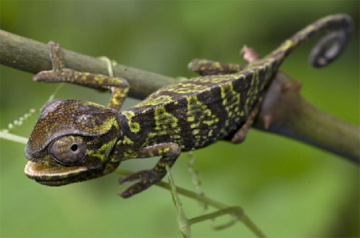 Chameleon (Chamaeleo gracilis). Photo by Piotr Naskrecki (CI) 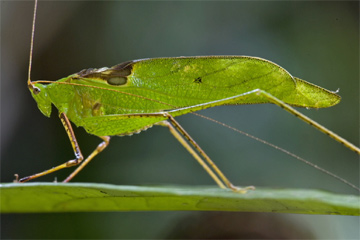 A new species of katydid (Tetraconcha sp. n.). Photo by Piotr Naskrecki (CI). The team found the highest diversity of katydids (grasshopper relative) in all of Africa, including eight species new to science, making 13% of all species of katydids in Atewa new to science. 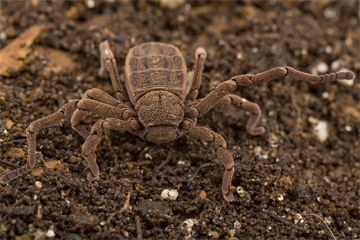 A new species of tick spider (Ricinoides sp. n.). Photo by Piotr Naskrecki (CI) 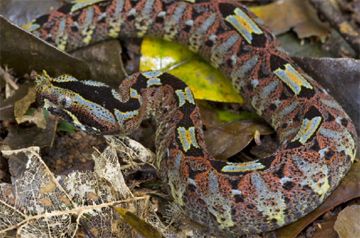 Rhinoceros viper (Bitis nasicornis). Photo by Piotr Naskrecki (CI) 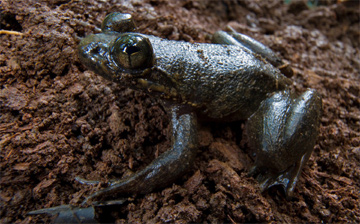 The aquatic Conraua derooi is Critically Endangered and may have its largest populations in the Atewa Range Forest Reserve. Photo by Piotr Naskrecki (CI) 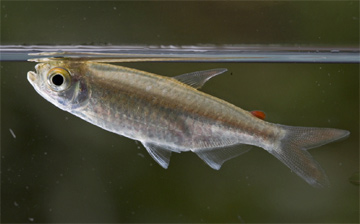 African tetra (Micralestes occidentalis). Photo by Piotr Naskrecki (CI). The expedition found 19 fish species of significant potential value in the aquarium trade. These species indicate that the streams run through high quality, intact forest, which is becoming exceedingly rare in West Africa. 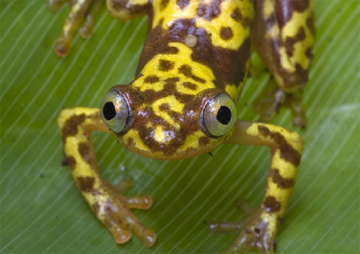 Frog (Afrixalus vebekensis). Photo by Piotr Naskrecki (CI) 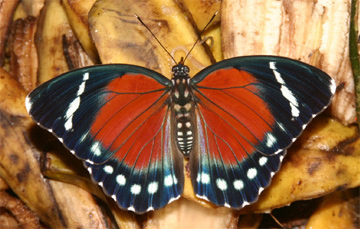 The Green Orange Forester – Euphaedra zampa (female; the male is metallic green) is endemic to the forests west of the Dahomey Gap. It is rare everywhere in Ghana except Atewa, where can be the commonest Euphaedra. Photo by Szabolcs Sáfián (CI). 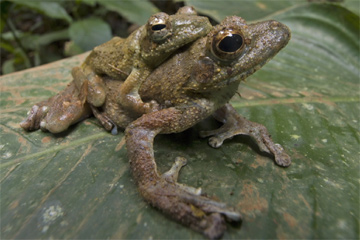 Tree frogs in amplexus (Chiromantis rufescens). Photo by Piotr Naskrecki (CI) 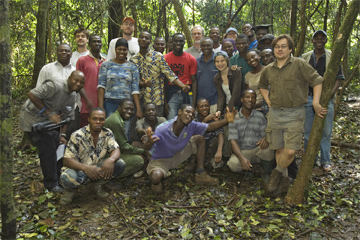 The Atewa RAP team. Photo by Piotr Naskrecki (CI) |
Scientists have discovered significant populations of new, rare and threatened species in one of the largest remaining blocks of tropical forest in West Africa, reports Conservation International (CI). The findings underscore the need to conserve the area’s high biological richness.
The discoveries were made during a 2006 expedition to Ghana’s Atewa Range Forest Reserve (Atewa) under CI’s Rapid Assessment Program (RAP), which deploys expert scientists to poorly understood regions in order to quickly assess the biological diversity of an area. CI makes RAP results immediately available to local and international decision makers to help support conservation action and biodiversity protection.
According to CI, “the RAP discoveries include a Critically Endangered frog species (Conraua derooi) whose presence in Atewa may represent the last viable population in the world; an unusually high 22 species of large mammals and six species of primates including two species of global conservation concern: Geoffroy’s pied colobus (Colobus vellerosus) and the olive colobus (Procolobus verus); 17 rare butterfly species; six bird species of global conservation concern including the brown-cheeked hornbill (Bycanistes cylindricus) and the Nimba flycatcher (Melaenornis annamarulae)(first time recorded in Ghana); and nine species new to science: a spider tick whose lineage is as old as the dinosaurs and eight species of katydids.”
The expedition also counted 155 bird species; 19 fish species of significant potential value in the aquarium trade; the highest diversity of katydids (grasshopper relative) in all of Africa; highest diversity of butterflies in Ghana; featuring 575 of the 925 species known to occur in Ghana (62% of Ghana’s butterfly fauna and twice the number of butterflies found in Europe); 10 mammal species of global and national conservation concern; and the only tree fern species (Cyathea manniana) found in Ghana.
“Atewa harbors one of the healthiest and most important ecosystems in Western Africa and is the crown jewel of Ghana,” said Leeanne Alonso, a Conservation International (CI) senior scientist who heads the RAP program. “This is an SOS to create with local communities and other stakeholders viable economic development options that also protect Atewa’s valuable natural resources.”
CI says the region is under threat from illegal logging and bushmeat hunting and that added pressure may come from future gold and bauxite mining exploration activities. To stem these risks, CI recommends that the Ghana government “upgrade the area’s protection status such as to a National Park, create of a buffer zone around the park and develop a management plan that includes conversation measures and economic development strategies compatible with conservation goals.” CI says the region holds potential for ecotourism and carbon credits under “avoided deforestation” mechanisms currently being discussed at the UN conference in Bali. Because also Atewa serves as a watershed for three river systems, the health of the forest in important for the local economy.
“While this forest has long been known to harbor a high number of species and to serve as an essential source of water for local villages and for Accra, it is only recently that the global importance of this reserve has been confirmed,” said Okyeame Ampadu-Agyei, CI-Ghana country director. “We must quickly take action to protect the incredible diversity of Atewa for future generations and to prevent the extinction of the 36 globally threatened species that we know to live in Atewa.”
Related articles
Pictures of newly discovered species in Suriname
(6/4/2007) Scientists documented 467 species, including 24 species believed new to science, during a rainforest survey in eastern Suriname, South America. The expedition, led by Conservation International (CI), was sponsored by two mining companies, BHP-Billiton Maatschappij Suriname (BMS) and Suriname Aluminium Company LLC (Suralco), hoping to mine the area for bauxite, the raw material used to make aluminum. Conservation International said the Rapid Assessment Survey (RAP) will help “give miners guidance on protecting unique plants and animals during potential future development,” according to a statement from the organization.
52 species discovered in Borneo rainforest
(12/18/2006) In 2006 scientists discovered 52 species in the highly threatened rainforests of Borneo according to a new report from WWF, an environmental group working to preserve the biodiverse ‘Heart of Borneo’ from further destruction.
Photos of newly discovered species in Brazil’s Amazon rainforest
(9/27/2006) Brazil has announced the creation of a Amapa State Forest, a 5.7 million acre Amazon protected area larger than the state of New Jersey. According to Conservation International (CI), “the designation protects a crucial section of the Amapa Biodiversity Corridor of northern Brazil, which includes some of the most pristine remaining Amazon forest.” The Amapa Biodiversity Corridor — which includes a variety of ecosystems including tropical forests, mangrove swamps, savannah, and wetlands — is home to more than 1,700 species of animals and plants, including 430 species of birds, 104 species of amphibians, 124 reptile species and 127 mammal species, including 62 bat species, according to biological surveys conducted by Conservation International (CI) and the Amapa State Institute for Research. At the core of the Amapa Biodiversity Corridor is Tumucumaque National Park, the world’s largest tropical forest park.
Pictures of new species discovered in New Guinea
(2/7/2006) A team of scientists led by Conservation International (CI) found dozens of new species in a survey of New Guinea’s Foja Mountains. The December 2005 trip by a team of U.S., Indonesian, and Australian scientists discovered new species of frogs, butterflies, plants, and an orange-faced honeyeater, the first new bird from the island of New Guinea in more than 60 years.